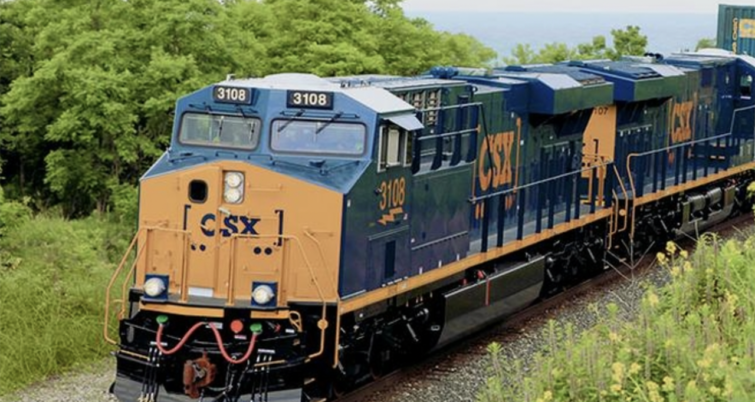CSX: Failed Wheel Bearing Behind Kentucky Derailment
Written by Marybeth Luczak, Executive Editor, Railway Age
ROCKCASTLE COUNTY, Ky. – An investigation has determined that a failed railcar wheel bearing caused the Nov. 22 CSX train derailment just north of Livingston, Ky., the Class I railroad reported Nov. 26. Sixteen cars, including two molten sulphur cars that breached and caught fire, were involved.
Kentucky Gov. Andy Beshear on Nov. 22 declared a state of emergency following the derailment, allowing the state to activate resources as needed to help. CSX and local emergency responders in Rockcastle County, Ky., worked through the night into Thanksgiving, Nov. 23, to extinguish the fire.
According to CSX, specialized equipment was deployed “to conduct air monitoring in the area as molten sulphur is known to release sulphur dioxide when it burns.” Authorities recommended that residents in the city of Livingston and the surrounding area evacuate to Rockcastle County Middle School, reported the Class I, which also secured hotels and worked with local restaurants and a Dollar Tree in Mt. Vernon, Ky., to provide meals and other necessities for affected residents. The railroad covered the cost for these provisions. CSX also provided Thanksgiving dinner for residents on Nov. 23 at First Christian Church and Rockcastle County Middle School. Residents were able to return to their homes the same day.
CSX spokesman Bryan Tucker told the Associated Press (AP) that since the fire was put out, no sulfur dioxide had been detected.
According to the AP’s Nov. 27 report, Tucker “said the bearing that failed didn’t get hot enough to trigger an alarm from the last one of the railroad’s trackside detectors that the train passed, so the crew didn’t get any warning before the derailment. A wheel bearing has to be at least 170 degrees hotter than the ambient temperature to trigger an alarm. The train traveled about 21 miles after the last detector and was two miles away from the next one along the tracks. Across all of CSX’s networks in the eastern United States, those detectors are an average of 14.9 miles apart, but on less-traveled tracks that don’t include passenger traffic the detectors can be farther apart. Tucker said that was the case here.”
CSX on Nov. 25 completed the removal of all 16 derailed cars, which also included two carrying magnesium hydroxide that were not breached; the remaining cars were either empty or carrying non-hazardous products like grain or plastic, the railroad said.
CSX reported working in close coordination with local authorities and the U.S. Environmental Protection Agency to clean up and restore the incident site. Early on Nov. 26, crews “successfully removed all of the released product and approximately 2,500 tons of impacted soil and replaced it with clean material,” said the railroad, noting that continuous monitoring of both the air and surface water quality was performed until all railcars and materials from the site were removed. CSX’s engineering teams on Nov. 26 were “in the process of repairing the tracks and restoring service on the rail line,” which was expected to be completed the same day.
“CSX extends its deepest gratitude to Rockcastle County authorities for their support and close collaboration throughout the response to this incident,” the Class I said. “We are also thankful for the community members and local businesses that worked with us to help residents that were affected, especially those that assisted us in serving Thanksgiving dinners for the community. CSX apologizes for the inconvenience this incident caused the local community and is appreciative for everyone’s patience throughout the recovery effort. CSX is still offering support to affected residents and we encourage them to contact 1-800-805-9840 for information.”
According to the railroad, the CSX Outreach Center in Livingston will continue to be open from 8 a.m. to 6 p.m. on Nov. 27 “to reimburse affected residents for any wage loss, out of pocket expenses and other inconveniences.” Tucker told the AP that approximately 400 households have applied for reimbursement so far.
CSX said it will “continue to coordinate with emergency personnel and local authorities to ensure that those living and working in the Livingston community will receive the most up-to-date information possible.” Updates for the community are posted on www.csx.com/response.





